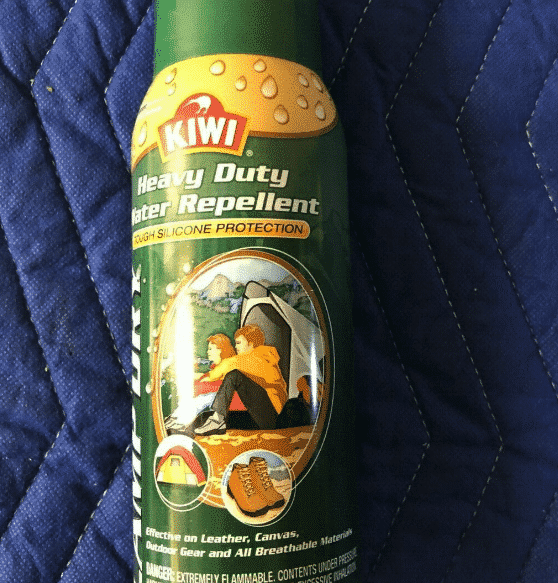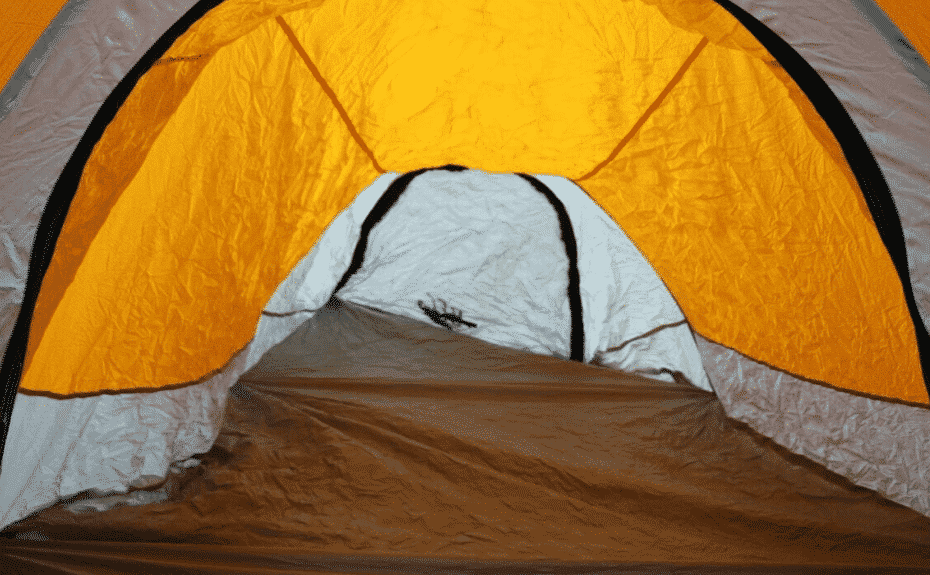Nothing can ruin a camping trip faster than a rainstorm. Nobody wants to spend their precious vacation time cooped up in a tent, but it could be worse.
What if your tent’s floor just started to leak out of nowhere? Trust me, a wet tent floor sucks. All your gear is going to get soaked and you’ll be cold and miserable.
A wet tent floor is going to put a serious damper on your camping trip, but it doesn’t have to. With a little prep work, you can cheaply and easily waterproof your tent floor.
Table Of Contents
Do You Need to Waterproof a Tent Floor?
Although you probably don’t need to waterproof a tent straight out of the package it’s always a good idea. Tents just aren’t designed to be completely waterproof. In a serious downpour, your tent is going to leak, usually through the floor.
Most people just assume their tent is going to be waterproof straight out of the box. They might be water-resistant in light rain, but who knows what’s going to happen in a downpour. It takes a well-designed tent to resist water once it starts to pool.
Unless you spend a small fortune your tent will probably leak. Even expensive tents will eventually start to leak as the water repellent coating wears away.
You don’t want to get stuck out in a rainstorm with a tent that leaks(that sucks). You’re going to be seriously uncomfortable, cold, wet and might even destroy your gear. Sleeping in a wet tent can be downright dangerous if you catch hypothermia.
How Does Factory Waterproofing Work?
Most tents are labeled as waterproof, but what does that actually mean? Even tents labeled as waterproof will eventually leak in a serious storm. They just can’t seem to waterproof every single inch of a tent.
Manufacturers just don’t have the quality control necessary to completely waterproof a tent. They strategically apply waterproofing over the floor, rainfly, etc, but there are no guarantees.
They use a cheap DWR coating that just doesn’t hold up. It might be good enough for a few trips, but it will eventually wear away. Usually somewhere along a seam in the floor of the tent.
Once it springs a leak, you’re screwed. Unless you reapply waterproofing, the leak is going to keep getting worse. Luckily, it’s actually pretty easy to fix a leak in your tent’s floor.
How to Waterproof a Tent Floor
So how exactly do you waterproof your tent’s floor? Don’t worry, it’s not that difficult. All you need is a good waterproof seam sealant, DWR spray and a little bit of time. Just make sure your waterproofing products are specifically designed for tents.
What Do You Need to Waterproof a Tent Floor?

Waterproofing a tent floor is actually pretty easy and fairly easy. Just head down to your local sporting good store or check online. Luckily, you shouldn’t need to spend much to waterproof your tent.
- Seam Sealant: Gear Aid Seam Grip (On Amazon), or Coleman Seam Sealer (On Amazon)
- DWR Spray: Kiwi Camp Dry (On Amazon)
Where Should I Focus?
Your tent probably already has some waterproofing straight out of the box. The manufacturer usually just dusts the inside floor with a waterproofing spray without doing much on the outside. With a new tent, you can usually see where they applied waterproofing (it’s shiny).
Think about where water is most likely to leak in. Focus on the tent seams and the first 1-2 feet of the tent. DWR Spray is cheap so I definitely recommend spraying everything down both inside and out. Then you’ll want to focus on the outside seams.
Only Apply Waterproofing to a Dry Tent
Just like paint, waterproofing sprays will only work when the tent is completely dry and clean. Make sure there’s no caked-on dirt/grime and wash the tent if necessary.
Once you’re laying down in the tent and feel water pouring in it’s too late. A little bit of duct tape might get you out of a jam, but it won’t last for long. You’ll have to suffer it out for the night and reapply waterproofing once you get home.
Wait for a sunny day and set up your tent in the backyard. You’ll need at least 24 hours for the water repellent coating to fully cure before you can take the tent down.
Waterproofing Your Tents Floor
So how exactly do you go about waterproofing the floor of your tent? Head down to your local outdoor store or look online for waterproofing products specifically designed for tents. Once you have a good waterproofing spray (my favorite) and grip sealant (my favorite) it’s time to go to work.
- Wait for a dry sunny day to setup your tent. You need at least 24 hours for the waterproofing to fully cure.
- Set your tent up in the backyard or head down to the local campground. If you apply the product to the inside of your tents floor in the morning it should be dry before you head to bed. Don’t worry waterproofing sprays shouldn’t damage your sleeping bag, backpack, etc.
- Make sure your tent is completely dry and there’s no visible dirt/grime. A little bit of dust or dirt isn’t a big deal, but try to get rid of as much as you can.
- Refer to the manufacturers directions and apply the waterproofing agent accordingly. For best results apply multiple coats(at least 2). Timing is key, try to apply the second coat as the first one is drying. Waiting until the first coat completely dries will make the waterproofing agent less effective.
- Start off by applying a waterproofing spray to the inside of your tent. Might as well spray the entirety of your tent floor, wall, ceiling, etc. Focus on the high impact areas near the entry and outside edges.
- Once the inside is coated with DWR spray go over all the seams with seam sealant. A little bit of seam sealant goes a long way. Put on a thin layer since a thick bead of sealant is much more likely to rub away.
- Once the inside is done work your way to the outside focusing on the bottom 1-2 feet of the tent. You should really only need to work on the outer edge of the tent where water pools. Use a tent footprint to protect the bottom of your tent from punctures and tears.
Other Tips to Keep The Inside of Your Tent Dry
- Use a tent footprint, tarp or ground cloth to protect the bottom of your tent from punctures. Go with a footprint 2-3 inches smaller than the outside edge of your tent. If the footprint is bigger than the tent water will pool on the fabric.
- Before setting up your tent look for signs of pooling water. A little bit of mud will turn into a mud pit with light rain. Look for higher ground than the surrounding areas so water drains away from your camp site.
- If the inside of your tent’s floor is leaking there’s not much you can do. Try to find the leak and apply a piece of duct tape to slow down the leak. Place a tarp over the leak for short term comfort.
- Most moisture is actually the result of tent condensation. Condensation is hard to fight, but removing water sources and ventilating your tent is a great start. Check out my post on preventing tent condensation.
- Let your tent dry completely before putting it back into storage. A little bit of moisture will quickly destroy a tent.




